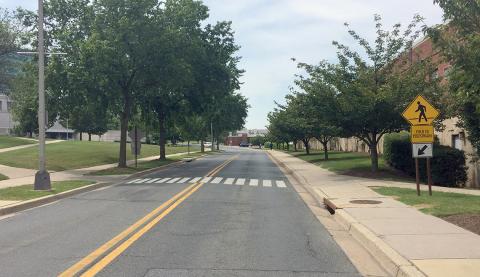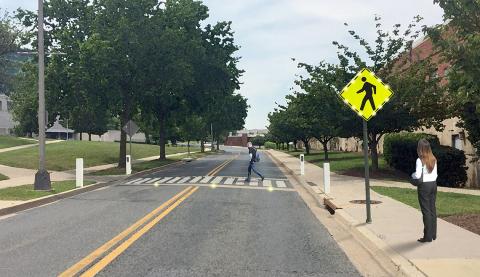Improving Campus Pedestrian Safety Through Technology

Since 2014, 8 pedestrians and 1 bicyclist have been struck by vehicles on the Bethesda campus. It’s a sobering statistic. Even one accident is too many.
If you’ve walked on Center Dr. near Bldg. 3 or Lincoln Dr. between Multi-Level Parking Garage 6 and Bldg. 35, you’ve seen the latest measure installed on campus to address pedestrian safety. Using photo-electric sensors and directional infrared light, these pedestrian-activated, LED-lit crosswalks and flashing warning signs are typically in the middle of a block where there is no stop or yield sign. Once activated, the in-road lighting is directed at the eye level of motorists and cyclists, alerting them to pedestrians already in the crosswalk and increasing drivers’ warning times.

Many other places are also adopting this pedestrian safety technology, with Walter Reed, the City of Charlottesville, James Madison University, Norfolk Naval Base and Bolling Air Force Base as examples. More lighted crosswalks and warning signs are coming. This summer and fall, 12 additional crosswalks will be upgraded around campus with 8 more planned for the future. Locations were determined with NIH community input, selecting places with high-volume vehicle traffic, high-volume pedestrian traffic or both.
Even though additional lighted crosswalks will help NIH become a safer campus for all, they don’t replace the need for everyone to follow the rules of the road. NIH follows State of Maryland and Montgomery County laws as they pertain to pedestrian right-of-way. At a crosswalk, in most situations, the pedestrian has the right-of-way and a vehicle should come to a complete stop while a pedestrian is crossing or approaching the roadway. However, it’s not all on the driver. Maryland code also states “…a pedestrian may not suddenly leave a curb…and walk into the path of a vehicle which is so close that it is impossible for the driver to yield” safely. Also, no bike or other vehicle may pass another vehicle stopped to let a pedestrian cross the roadway.
Installation of these improvements has already begun. No road closures are expected. Lane closures are limited to nights and weekends and one lane of traffic will be open at all times. The Office of Research Facilities project officer overseeing installation is Michael Oppelt. He can be reached at michael.oppelt@nih.gov or (301) 435-7827.
